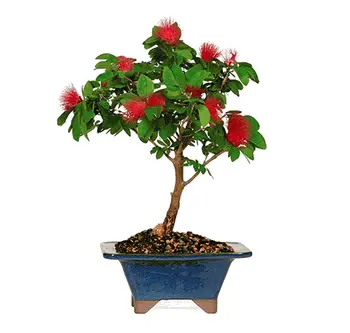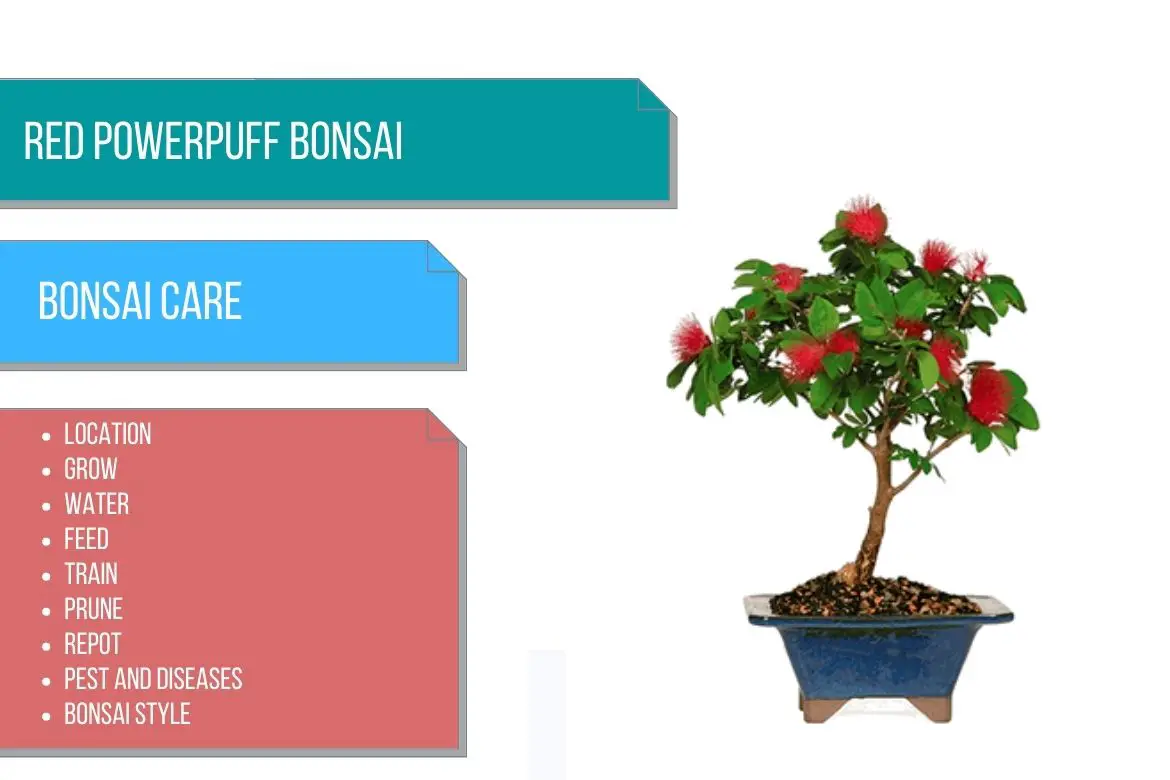
Red Powder-Puff
(Calliandra haematocephala)
Country of Origin : South America
Bonsai Styles : Informal upright, Formal upright, semi-cascade, cascade, clump
Zone : 9 – 11
There are more than 120 species of Calliandra plants native to tropical and subtropical regions in the Americas (specifically Bolivia). However, they are also found in Asia and India.
The Calliandra haematocephala plant is a small, evergreen bush that has lovely, green, fragrant, double-feathered leaves that close up at night or when the plant is subjected to drought. The leaves are alternate and oval in shape.
There is another Calliandra plant species that can be used to make a bonsai: Calliandra surinamensis / Calliandra Surinam – pink powder puff bonsai tree.
The dwarf version Calliandra haematocephala ‘Nana’ can also be used to make a bonsai and will have the same care instructions.
Calliandra haematocephala grows red “powder-puff-like” flowers. In late spring through summer, the flower buds, which make up the flowers, grow from the axils of the leaves and have a raspberry-like appearance.
A leathery leguminous fruit grows from the flowers, bursting open when ripe and curling up afterwards.
Young red powder puff plants have a light gray trunk that darkens to almost black as the plant matures.
Red powder puff bonsai can be grown as an exotic flowering bonsai tree that will certainly brighten your room as an indoor bonsai tree as well.
Please also refer to types of bonsai trees for care guides on other bonsai tree species.
Best location to keep Red Powder puff Bonsai
Red powder puff bonsai trees can be placed indoor throughout the year. However, place the bonsai tree where there is plenty of light and ventilation.
When keeping the red Powder puff bonsai tree indoors, keep the bonsai pot on a south or west facing window or windowsill for maximum sun exposure.
You can also put the bonsai tree in an outdoor location in mid-spring after the danger of frost has passed. Keep it in a partially shaded location.
These trees prefer cool winters. Hence, in the winter, place the bonsai in a bright and cool place. Keep it in a temperature range of 59°F to 64°F (15 to 18°C).
Bonsai should not be placed near a heat source.
In a cooler climate, this tree makes a great indoor bonsai tree, and in a warmer climate, it makes a stunning outdoor bonsai tree.
Refer sunlight requirements for indoor plants for more indoor gardening ideas. Also, refer to do bonsai trees need sunlight for more indoor and outdoor bonsai location ideas.
Propagation of Red Powder puff tree
Red powder puff tree can be propagated by using seeds, air layering and cuttings.
Sowing seed can be done in spring and early fall. In contrast to chemical scarification or heat treatment, mechanical scarification, nicking or roughing of the seed coat results in better germination.
While taking stem cuttings, use the stem tips and plant them in spring or early summer. Apply some rooting hormone and keep it in a temperature of 75°F (23°C). The stem cuttings will root quickly.
Watering Red Powder puff Bonsai
Water the bonsai tree regularly during the growing season, making sure that the soil is evenly moist.
If the bonsai is kept cool during the winter months, it will need less water.
These tree also prefer humid environment. Hence increasing the surrounding humidity by misting, humidifier or water tray is advisable in dry rooms. Refer to indoor bonsai tree care for more details.
Once established, the red powder puff plant is drought-tolerant. It is critical, however, to keep the bonsai free of drought when grown in a container.
Read watering bonsai tree for more details about immersion technique.
Wiring Red Powder puff Bonsai
Wiring can be performed at any time of the year for this species due to its resilience. However, spring and summer time is advisable for wire training.
You should only wire young branches that are just beginning to lignify (turn woody). Branches that are older are brittle. Therefore, wire training runs the risk of breaking them.
The bark of the tree is relatively thin. Take care not to scare the bark with the wire.
Please read our detailed guide on how to wire bonsai tree.
Pruning Red Powder puff Bonsai
When to prune red Powder puff bonsai?
How to prune red Powder puff bonsai?
Pruning of red powder puff bonsai tree can be done at any time of the growing season, in mid-spring and summer.
New shoots should be pruned to 1 to 2 leaves once they have developed 5 to 6 new leaves.
Red powderpuff plants respond well to heavy pruning by producing more flowers and denser foliage.
However, red powder puff bonsai trees look best when they have dense canopy and many flowers. Therefore, avoid over-pruning.
Deadhead your Powder Puff as soon as the blossoms fade to keep it blooming all year. Spring and summer will produce the best blooms, however.
Some of the new branches on the tree will grow thin and weak. Remove the spindly branch by cutting it back to a node (that will grow a branch which is pointing in your preferred direction).
Now, let that branch grow and cut it back again. This is called the ‘clip-and-grow‘ pruning method. Continue this till you are satisfied with the strength and shape of the branch.
If you want to prune the trunk, do it while the plant is still young. In older trees the trunk becomes more rigid.
Please read our detailed guide on how to prune a bonsai tree.
Repotting Red Powder puff Bonsai
When to repot Powder puff bonsai?
Red Powder puff bonsai tree can be repotted every second year in spring. Prune the roots of the tree at the time of repotting. Do not remove 1/3 of the total root mass. Removing more roots will result in the tree dropping its leaves.
Early summer is also a good time to repot the tree. At this time the weather is warm and nice and the plant is in active growth.
You can use a free-draining, slightly acidic bonsai soil mix. You can also use a bonsai soil mix that contains peat, loam and sand at the ratio of 1:1:1.
Please read our detailed guide on how to repot a bonsai tree. It will also give you all the details on how to prune the roots of a bonsai tree.
Must Read: Bonsai Soil Recipes
Must read : Choosing the right bonsai container
Feeding Red Powder puff Bonsai
During the growing season, from spring to summer, use liquid bonsai fertilizer every two weeks.
Applying a feed rich in phosphorus will increase flowering.
Do not feed your bonsai during the winter months.
Read more about bonsai fertilizer and its application.
Diseases and pest of Red Powder puff Bonsai
Red powder puff bonsai tree has the potential of getting infested by aphids, scales and mealybug. Mealybugs will cause defoliation, stunted growth of the tree and wilting of leaves.
You can remove the aphids manually by hand. You can also keep the bonsai outdoors and spray a water-jet to drop the aphids from the tree.
Use a systemic insecticide if the infestation persists.
You can also remove mealybugs by hand. Or you can spray the affected leaves with soapy water and rub the affected leaves with 70% Isopropyl alcohol using a cotton ball.
Please read our detailed guide on bonsai tree pest and diseases identification and remedies. This guide will also provide you with all the organic and inorganic solutions you can employ.

